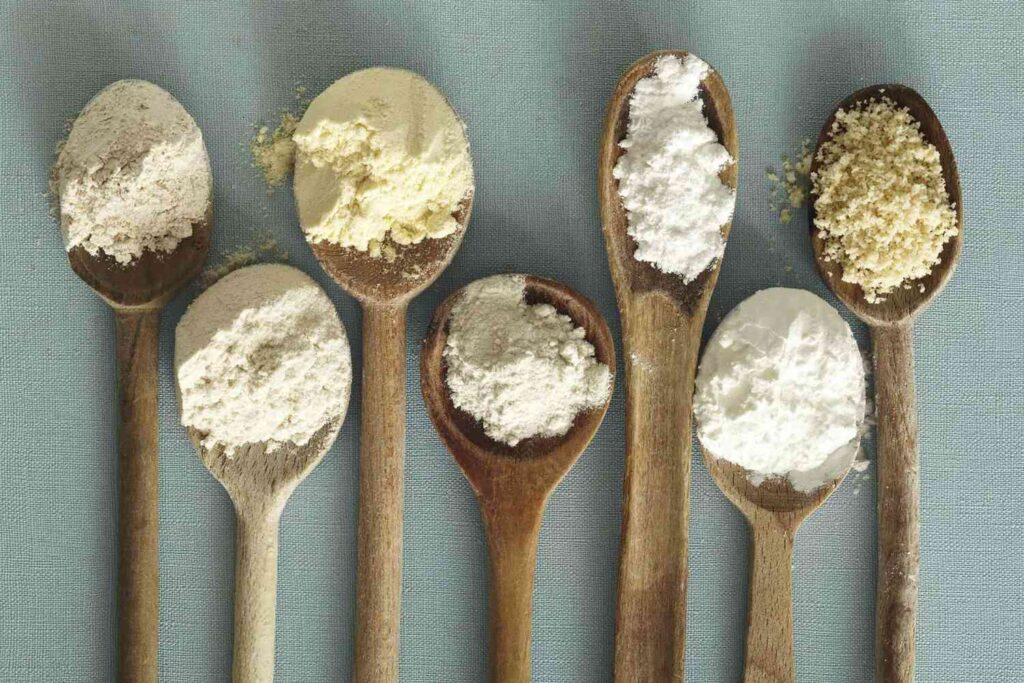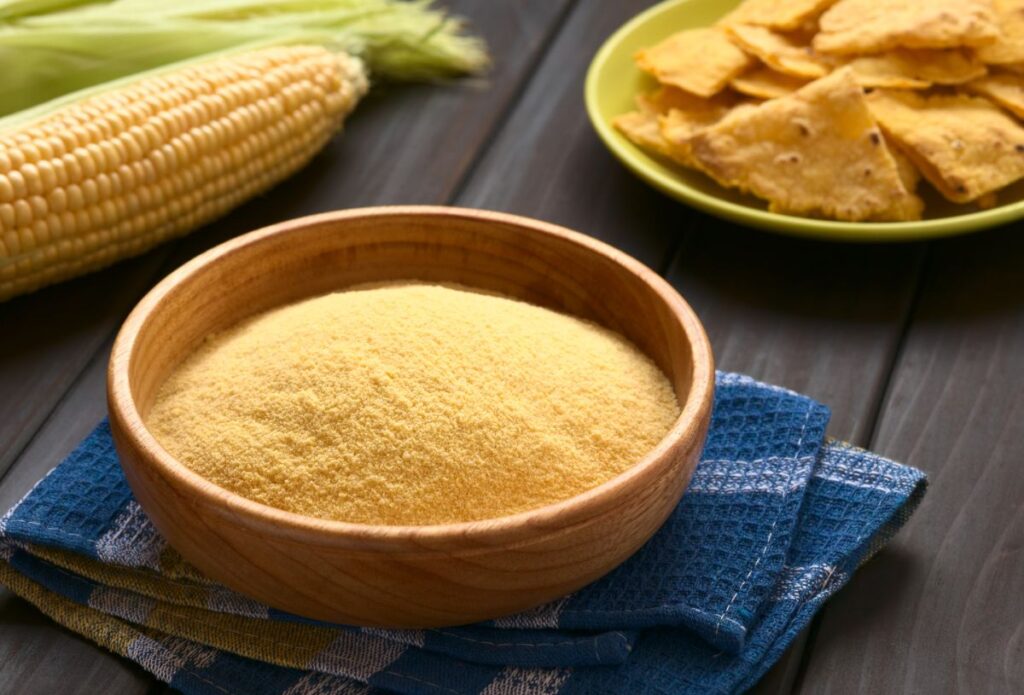Yes, you can use flour as a substitute for cornflour in certain situations. Both are thickening agents, but there are differences in texture and flavor. When substituting, keep in mind that flour has a more pronounced taste and may result in a slightly different texture. It works well in recipes where the distinctive properties of cornflour aren’t necessary.
For thickening soups, sauces, or gravies, a roux (flour and fat mixture) can be a suitable replacement. However, in recipes specifically calling for the unique attributes of cornflour, like tempura batter or certain desserts, it’s best to stick to cornflour for optimal results.
What is Cornflour and How is it Different from Regular Flour?
Cornflour often confused with cornmeal, is a finely ground powder made from corn kernels. It differs from regular flour, which is typically made from wheat. The key distinctions lie in their sources and characteristics.
Cornflour derived from corn, has a finer texture and imparts a slightly sweet flavor to dishes. On the other hand, regular flour, made from wheat, is more versatile and neutral in taste. While both serve as thickeners in recipes, cornflour excels in creating a smoother texture and is often preferred in gluten-free cooking.
What Sets Flour Apart from Cornflour in Cooking?

Flour and cornflour have distinct characteristics that set them apart in cooking
Source and Composition
Flour: Primarily derived from wheat, flour contains gluten—a protein that provides structure and elasticity. This makes it suitable for recipes like bread and pasta.
Cornflour: Made from corn kernels, cornflour is gluten-free. Its composition results in a finer texture and unique properties that are advantageous in specific culinary applications.
Texture and Consistency
Flour: With gluten contributing to its structure, flour produces a chewier and denser texture in baked goods and pasta.
Cornflour: Without gluten, cornflour contributes to a smoother and lighter texture, making it ideal for achieving silkiness in sauces, custards, and certain desserts.
Flavor Profile
Flour: Neutral in taste, flour doesn’t impart a distinct flavor to dishes, allowing it to adapt to various recipes without altering the overall taste.
Cornflour: Adds a subtle sweet flavor to dishes, enhancing the taste, especially in desserts and recipes where a hint of sweetness is desirable.
Versatility
Flour: Highly versatile, flour is a staple in a wide range of recipes, including bread, pastries, and savory dishes.
Cornflour: Specialized in its use, cornflour is often employed as a thickening agent in sauces, gravies, and desserts, providing a specific texture and clarity.
Gluten Content
Flour: Contains gluten, making it a crucial ingredient for recipes requiring dough elasticity and structure.
Cornflour: Gluten-free, making it suitable for those with gluten sensitivities and an excellent choice for achieving certain textures without the need for gluten.
Can You Use Flour Instead Of Cornflour?
Yes, flour can be used as a substitute for cornflour in various culinary scenarios. However, it’s essential to consider the specific attributes of both ingredients to determine when such a substitution is appropriate.
When Using Flour is Appropriate
Thickening Sauces and Gravies: Flour, when used in the form of a roux (a mixture of flour and fat), is an effective thickening agent for sauces and gravies. It imparts a slightly different texture but is generally suitable in many savory recipes.
Baking: In recipes where the unique characteristics of cornflour are not crucial, such as in cookies, muffins, or certain cakes, flour can serve as a suitable replacement. Adjustments may be needed to account for differences in texture and taste.
Budget Constraints or Availability: In situations where cornflour may not be readily available, or if you’re looking for a cost-effective alternative, using flour can be a practical solution.
When it Might Not be Ideal
Distinctive Cornflour Properties: In recipes where cornflour contributes to a specific texture, such as in tempura batter or certain desserts, substituting flour may not replicate the intended outcome.
Gluten-Free Requirements: If you’re adhering to a gluten-free diet or cooking for individuals with gluten sensitivities, it’s important to note that flour contains gluten, while cornflour is gluten-free. In such cases, choosing an alternative gluten-free thickening agent may be more suitable.
Flavor Considerations: Flour has a more pronounced taste compared to the subtle sweetness of cornflour. In recipes where this flavor difference may be noticeable, careful consideration should be given to the choice of substitute.
Can You Share a Recipe Where Flour Excels as a Cornflour Substitute?

Creamy Chicken and Mushroom Pasta Sauce
Ingredients
- 2 tablespoons butter
- 2 tablespoons all-purpose flour
- 1 cup chicken broth
- 1 cup milk
- 1 cup sliced mushrooms
- 1 cup cooked chicken, shredded
- 2 cloves garlic, minced
- Salt and pepper to taste
- 2 tablespoons grated Parmesan cheese
- Fresh parsley for garnish
- 8 oz cooked pasta of your choice
Instructions
Prepare the Roux: In a saucepan, melt butter over medium heat. Add flour, stirring continuously to create a roux. Cook for 2-3 minutes until it forms a smooth paste.
Add Garlic and Mushrooms: Stir in minced garlic and sliced mushrooms. Cook until mushrooms are tender and garlic is fragrant.
Gradually Add Liquid: Slowly whisk in chicken broth and milk, ensuring the roux integrates smoothly. Continue stirring to avoid lumps.
Thicken the Sauce: Allow the mixture to simmer and thicken. Adjust the heat as needed. The flour in the roux serves as an excellent thickening agent for the sauce.
Season and Add Chicken: Season the sauce with salt and pepper to taste. Add the cooked, shredded chicken to the sauce, allowing it to heat through.
Finish and Serve: Stir in grated Parmesan cheese, letting it melt into the sauce. Adjust the seasoning if necessary. Serve the creamy chicken and mushroom sauce over your favorite cooked pasta.
Notes
- The flour-based roux in this recipe effectively replaces cornflour, providing a creamy and velvety texture to the sauce.
- Adjust the thickness of the sauce by adding more or less flour in the roux, depending on your preference.
- Feel free to customize by adding additional vegetables, herbs, or spices to enhance the flavor.
FAQ
Can I replace cornflour with plain flour?
Yes, you can substitute plain flour for cornflour in certain situations. However, be mindful of differences in texture and taste, and adjust quantities accordingly.
What can I use if I don’t have corn flour?
If you don’t have cornflour, you can use alternatives like all-purpose flour, arrowroot powder, tapioca starch, or potato starch based on your recipe requirements.
What happens if I use flour instead of cornstarch?
Using flour instead of cornstarch may alter the texture and flavor in recipes. Flour contains gluten, so adjustments are needed to maintain the intended outcome.
Can you use regular flour instead of cornflour to thicken?
Yes, regular flour can be used as a thickening agent, especially in savory dishes. Create a roux for sauces, soups, or gravies, but be mindful of flavor differences.
Can I use Maida instead of cornflour?
Yes, Maida (all-purpose flour) can be used as a substitute for cornflour in recipes. Adjust quantities based on the desired consistency.
How can I thicken without cornflour?
To thicken without cornflour, consider alternatives like arrowroot powder, tapioca starch, potato starch, or using a roux made from flour and fat.
How can I thicken curry without cornflour?
Thicken curry without cornflour by using yogurt, coconut milk, ground nuts, or pureed vegetables for a rich and flavorful consistency.
Final thoughts
You can use flour as a substitute for cornflour in various recipes. Just remember to consider the specific role of cornflour, make necessary adjustments, and be aware of flavor and texture differences. Whether you’re facing ingredient shortages or dietary preferences, flour can be a versatile alternative with a few tweaks.
Don’t hesitate to experiment in small batches, monitor the results, and enjoy the flexibility in your cooking. So, next time you wonder about swapping flour for cornflour, go ahead—with a bit of know-how, your dishes can still turn out delicious. Happy cooking!

